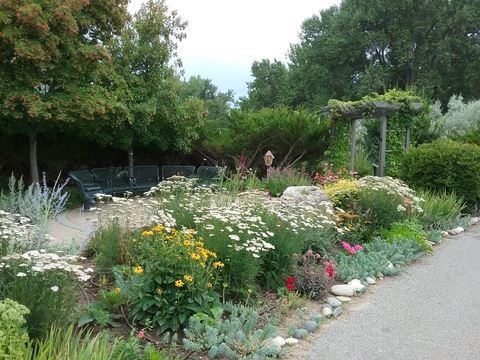Landscape design
Create a functional, easy to maintain, environmentally friendly, cost-effective, and aesthetically pleasing outdoor space for your home yard or garden.
- Select plants for long-lived, healthy and sustainable landscapes.
- Create special habitats for pollinators and other wildlife.
Creating a design
Landscaping can be exciting, fun and rewarding. But deciding how to get going on a project can be overwhelming. The five considerations of design are a good starting place, and the following videos on each of the considerations and a case study example explain the process.
Thinking through what you want to be able to do in your landscape, maintenance, and how to have a positive effect on the environment really helps guide the rest of your project toward a long-lasting and beautiful landscape.
Introduction to the 5 Considerations of Sustainable Landscape Design (00:05:28)
Functional considerations (00:06:24)
Maintenance considerations (00:12:01)
Environmentally sound considerations (00:03:46)
Cost effective considerations (00:02:57)
Visual appeal considerations (00:02:49)
Case study: Applying the 5 considerations of sustainable design to a home landscape (00:15:45)
The Sustainable Urban Landscape Information Series (SULIS) is a collection of advice and how-to articles on landscape design, plant selection, implementation and maintenance. These articles form a curriculum for landscape designers as well as easy-to-follow instructions for home landscapers.
- Design: The first step in creating a sustainable landscape
- Implementation: Preparation, planting, installation, and construction.
- Maintenance: Sustainable practices for lawns, and herbaceous and woody plants.
How and why to build a rain garden
Native grasses for butterflies and moths
Plants and landscapes to support pollinators — Lists of resources and videos to get you started and keep you going.
Planting and maintaining a bee lawn
Planting and maintaining a fine fescue lawn
Planting and maintaining a prairie garden
Home owners often ask Extension how to find a student, a Master Gardener or an industry professional to help them with a home landscaping project or garden design.
Landscape professionals
Landscape professionals typically have a degree in landscape design or a related area, or are licensed as a landscape architect. Some garden centers offer full service landscape design, implementation and maintenance services.
Homeowners can find firms by searching the Minnesota Nursery and Landscape Association website. Use the search function to find the type of help you are looking for in your geographical location—for example, "landscape designer St. Paul, MN".
Word-of-mouth is also a very good way to find a landscape professional. When you see a landscape you love, ask the homeowner for a recommendation.
Master Gardeners
Master Gardeners are educated by University of Minnesota Extension and volunteer by teaching research-based horticulture information in their communities.
While Master Gardeners are volunteers and not allowed to accept payment or work on private properties as part of their volunteer hours, some are professional gardeners, designers or landscape architects by trade. A county program may have a website or newsletter for volunteers where job postings can be published. You can send a job description for your landscaping project to the Extension Master Gardener program in your county.
Students or alumni
To reach students looking for seasonal work or alumni in the landscape business, post a job description on GoldPass: Job, Internship and Volunteer Listings. GoldPASS is the U of M's online database to help connect students and alumni with employers, volunteer organizations and internships across the country. Posting is free, easy to do, and open to anyone.
Selecting plants
The "Right plant, right place" 3-part video series shows you how to
- assess your planting site for soil, sun and space;
- select plant options using the Plant Elements of Design database;
- and finally, how to plant the plant.
Right plant, right place: Part 1 (8:44)
Right plant, right place: Part 2 (7:54)
Right plant, right place: Part 3 (4:10)
The Plant Elements of Design plant selection program will help you find plants that match the conditions of your landscaping site.
- Go to the Plant Elements site
- Click on CREATE AN ACCOUNT
- Enter your email address
- Create a password
- Click LOGON
- Respond to your account confirmation email
- Sent from Plantselection No-reply@umn.edu
Planting and maintaining a fine fescue lawn
Planting and maintaining a prairie garden: Common prairie plants
Ornamental grasses for shady sites
- Choosing evergreens for your landscape
- Select trees and shrubs for Minnesota landscapes
- Fall color trees
- More Minnesota trees
- Shrubs that provide color through fall and winter
- Flowering shrubs
- Trees and shrubs for pollinators
- Clean and disinfect gardening tools and containers
- The effects of deicing salts on landscapes
- Hiring a tree care professional
- How to manage flood damage to trees
- How to manage deer damage on trees and other plants
- How to manage vole damage on lawns, trees and shrubs
- Planting and transplanting trees and shrubs
- Pruning trees and shrubs
- Staking and guying trees
- Storm damage to landscape trees
- Watering established trees and shrubs
- Watering newly planted trees and shrubs
- Winter care for trees and shrubs
- Woody vegetation control
Stay up to date
- Read Yard and Garden News
- Listen to the Smart Gardens and What's Killing My Kale? podcasts.


